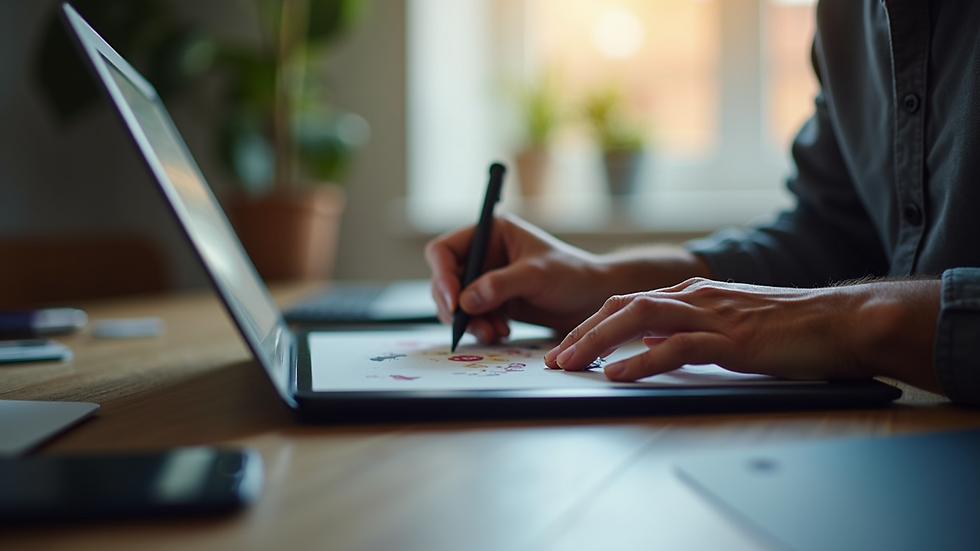Exploring Tools to Boost Your Creative Vision
- Sep 1
- 4 min read
In today’s fast-paced world, creativity is a vital skill that can set you apart in any field. Whether you are an artist, designer, writer, or entrepreneur, having the right creative tools can significantly enhance your ability to bring ideas to life. This article explores various creative tools that can help you unlock your full potential and transform your vision into reality.
The Importance of Creative Tools in Enhancing Productivity
Creative tools are more than just gadgets or software; they are enablers that streamline your workflow and inspire innovation. Using the right tools can help you:
Organize your ideas efficiently
Collaborate with others seamlessly
Experiment with new concepts without fear of failure
Save time by automating repetitive tasks
For example, digital sketchpads like the iPad Pro combined with the Apple Pencil allow artists to draw and edit with precision and flexibility. Similarly, writing apps such as Scrivener help authors structure their manuscripts and keep track of research materials.

Exploring Popular Creative Tools for Different Disciplines
Creative tools come in many forms, tailored to specific needs and industries. Here are some popular options categorized by discipline:
Visual Arts
Adobe Creative Cloud: A suite of applications including Photoshop, Illustrator, and Premiere Pro for photo editing, vector graphics, and video production.
Procreate: A powerful drawing app for iPad that offers a natural drawing experience with a wide range of brushes.
Canva: An easy-to-use graphic design platform perfect for creating social media posts, presentations, and marketing materials.
Writing and Content Creation
Grammarly: An AI-powered writing assistant that helps improve grammar, style, and tone.
Hemingway Editor: A tool that highlights complex sentences and suggests simpler alternatives to improve readability.
Google Docs: A cloud-based word processor that enables real-time collaboration and easy sharing.
Music and Audio Production
Ableton Live: A digital audio workstation (DAW) favored by electronic music producers for live performances and studio work.
GarageBand: A beginner-friendly DAW for Mac users to create music and podcasts.
Audacity: A free, open-source audio editor for recording and mixing sound.
Project Management and Collaboration
Trello: A visual project management tool that uses boards, lists, and cards to organize tasks.
Slack: A communication platform that integrates with many other tools to keep teams connected.
Notion: An all-in-one workspace for notes, tasks, databases, and collaboration.
Using these tools effectively can help you maintain focus, track progress, and bring your creative projects to completion.

What Does Creative Platform Mean?
A creative platform is a digital or physical environment that provides resources, tools, and community support to help creators develop and share their work. These platforms often combine multiple functionalities such as content creation, collaboration, and distribution.
For instance, platforms like Behance and Dribbble allow designers to showcase their portfolios, receive feedback, and connect with potential clients. Similarly, platforms like YouTube and SoundCloud enable musicians and video creators to publish their content and grow their audience.
Creative platforms are essential because they:
Foster collaboration by connecting creators with peers and mentors
Provide access to specialized tools and resources
Enable exposure to wider audiences and markets
One excellent example of a creative platform that supports diverse artistic endeavors is creative platforms, which offers a collaborative space for artists, designers, and creators to innovate and grow.

How to Choose the Right Creative Tools for Your Needs
Selecting the right creative tools depends on your goals, skill level, and budget. Here are some tips to help you make an informed decision:
Identify your primary creative focus: Are you a visual artist, writer, musician, or a multi-disciplinary creator? Choose tools that cater specifically to your craft.
Consider ease of use: Some tools have steep learning curves, while others are beginner-friendly. Pick one that matches your comfort level.
Evaluate compatibility: Ensure the tools work well with your existing hardware and software.
Look for community support: Tools with active user communities often provide tutorials, forums, and inspiration.
Test free trials: Many creative tools offer free versions or trials. Use these to explore features before committing financially.
For example, if you are a graphic designer just starting out, Canva might be a better choice than Adobe Illustrator due to its simplicity and affordability. Conversely, professionals might prefer Adobe’s advanced features despite the higher cost.
Tips to Maximize Your Creative Potential Using Tools
Having the right tools is just the beginning. To truly boost your creative vision, consider these actionable recommendations:
Set clear goals for each project to stay focused and motivated.
Experiment regularly with new tools and techniques to expand your skill set.
Create a dedicated workspace that minimizes distractions and inspires creativity.
Schedule time for creative breaks to recharge your mind and avoid burnout.
Seek feedback from peers or mentors to refine your work.
Keep learning through online courses, tutorials, and workshops.
By integrating these habits with your creative tools, you can build a productive and fulfilling creative practice.
Exploring and adopting the right creative tools can transform how you approach your projects. Whether you are sketching ideas, writing stories, producing music, or managing creative teams, the right resources empower you to bring your vision to life with confidence and efficiency. Embrace the possibilities that modern creative tools offer and watch your creativity flourish.




Comments